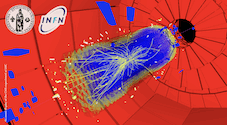Speaker
Prof.
Piero Spillantini
(INFN e Univerità di Firenze)
Description
GAMMA-400 is a space mission included in the Russian Federal Space Program and supported by the Russian Federal Space Agency. The main characteristics of the mission are a high elliptical orbit (initial parameters: perigee 500 km, apogee 300 000 km), a total mass for the scientific payload of 2600 kg, and a power budget for the instrument of 2 kW. The experiment is intended to improve the angular and energy resolutions obtained by other space missions for gamma-rays in a very large energy range (0.1-3000 GeV), to measure the cosmic-ray electron flux up to 3 TeV and to measure the cosmic-ray proton and nuclei fluxes up to (and above) 1 PeV/nucleon, thus allowing to reach the “knee” at least for protons and He. The apparatus will consist of a finely segmented converter/tracker (made by thin tungsten layers and sensitive planes of silicon microstrip detectors), and a deep (≥ 25X0), homogeneous imaging calorimeter for energy measurement. On the top of the Si-W converter/tracker, a light multilayer silicon tracking detector will extend the GAMMA-400 measuring capabilities for low- and medium-energy gamma rays in the range 50-300 MeV.
Authors
Prof.
Piero Spillantini
(INFN e Univerità di Firenze)
Dr
Valter Bonvicini
(INFN - Sezione di Trieste)

